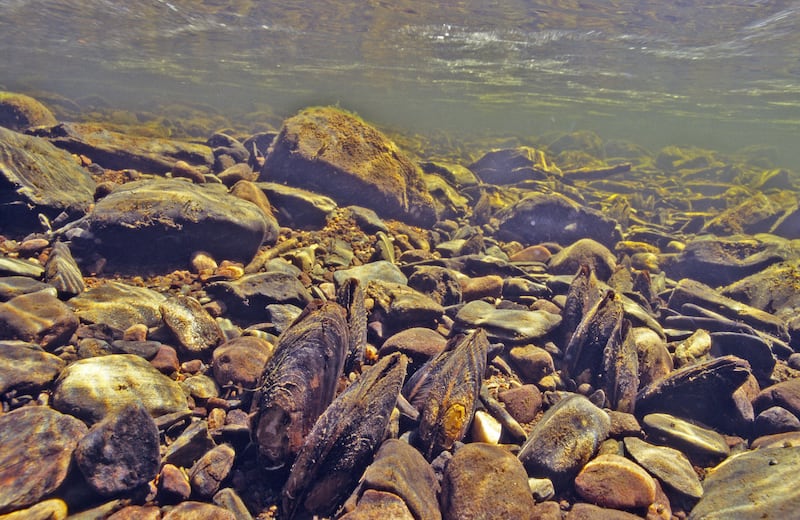One morning in the summer of 2006, I stood on the banks of the Nore in Dunmore Wood, just outside Durrow, Co Laois. With me was an Irish scientist who has dedicated her life to one of the world’s most critically endangered creatures, for which Ireland was considered one of the last remaining European strongholds. It’s a mollusc most of us have never seen or even heard of: the freshwater pearl mussel (Margaritifera magaritifera).
Dr Evelyn Moorkens, an international expert on this extraordinary species, had agreed to meet me along a stretch of the river where the remaining population of “Nore mussels” lived. In the late 1980s, some 5,000 adult mussels were in the river; by 2006, Dr Moorkens estimated about 500 were left. As they live on the riverbed, one careless footstep could be fatal. And so I watched from the banks as she stepped cautiously into the water, helped by a transparently bottomed bucket which she peered into before moving forward.
The Nore’s freshwater pearl mussels are an enigma. In all other Irish rivers where this species has been found, the water is soft and acidic. But the Nore mussel had acclimatised to the river’s hard, limestone-rich water. (This uniqueness was first identified by a Cork-born field naturalist, Robert Albert Phillips, in 1928.) While the Nore mussel isn’t considered a separate species, it is genetically distinct and unique.
Fortunately, it took only a short time before Dr Moorkens spotted one and lifted it out of the water to offer me a closer look. It was kidney-shaped and resembled a larger, darker, more substantial version of the common edible saltwater mussel. On the outer shell are concentric growth rings, like the rings of a tree, which are used to estimate their age. This one, she estimated, was 50 to 60 years old.
RM Block
It seems astonishing that a mollusc born in the 1940s or ’50s could still be alive, but this particular one was actually relatively young because freshwater pearl mussels can live up to 140 years. If they find a spot in the river that suits their needs, they stay put for their entire lives. As Dr Moorkens placed the mussel back in the water, she said it had likely spent decades in that one patch.
[ Irish waterways: the toll of years of draining, modification and engineeringOpens in new window ]
Anchored to the gravel floor of rivers by a large muscular foot, mussels spend their days and nights slowly inhaling vast quantities of fresh water (just over 100 pints a day) through siphons that filter out micro algae, phytoplankton, bacteria and other microorganisms to digest. Water in, water out: that’s their life, cleaning it to such a high standard that it’s probably safe for us to drink.
Adult mussels don’t even move when it’s time to breed. In June, triggered by rising water temperatures, the males eject millions of sperm through their siphons, hoping it finds its way downstream into the siphons of nearby females. The female fertilises the eggs and keeps them in a kangaroo-like pouch for about four weeks before releasing them into the river water.

Just fractions of a millimetre in size, the larvae hitch a ride on the gills of juvenile salmon and trout, which is a safe, well-oxygenated place to grow. It also moves the mussels along different parts of the river as the fish swim for food. In return, the fish are guaranteed gin-clear water, and the larvae will also filter out any potentially harmful bacteria.
By the following summer, the young mussels fall off the fish and burrow into the gravel bed. Like a newborn baby needing constant care, this is a precarious stage; the river and surrounding habitats must be maintained in good condition. Even one day of disturbance – a sudden surge in nutrients, silt or a change in water flow from drainage – will cause the juveniles to die. After five years buried away, they emerge as adults.
It’s an astonishing life cycle that requires clean, well-oxygenated waters in healthy, free-flowing rivers; the mussels are a bellwether for the state of our environment. There is no better indicator of pristine water quality than a successfully reproducing population of mussels in a river. But land and peatland drainage, intensification of agriculture, siltation, water pollution, and the planting and clear-felling of trees on upland bogs have all taken their toll. Since the 1980s, mussel numbers have plunged by 90 per cent across Europe. In Ireland, they are now in free-fall.
In 2009, detailed management plans for mussels in Special Areas of Conservation were drafted but never signed off by the minister of the day, and are now hopelessly outdated. In 2020, the National Parks and Wildlife Service commissioned a review of the overall status of the species across Ireland, with recommendations for immediate action. It has yet to be even published.
Last June, Ireland lost a case at the Court of Justice of the European Union, brought by the European Commission, over the State’s failure to implement environmental law on protected habitats, including those for the freshwater pearl mussels. If the Irish authorities don’t demonstrate plans to fix this soon, we face daily fines, paid for with public money.
What of the Nore mussels? Despite the ceaseless efforts of scientists such as Dr Moorkens, very few – perhaps 100 or so – remain at this stage. Freshwater pearl mussels in Irish rivers have full legal protection under Irish and European law. But what on earth is the point of it all if the laws are not implemented and, instead, continually broken?
Sign up for push alerts and have the best news, analysis and comment delivered directly to your phone
Find The Irish Times on WhatsApp and stay up to date
Our In The News podcast is now published daily - Find the latest episode here




















